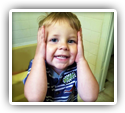
Improvement in Motor Developmental Speech Delay in Toddler Following Chiropractic Care
Print Article

The July 2018 issue of the Journal of Clinical Chiropractic Pediatrics published a case study documenting chiropractic care resulting in the improvement of speech and motor development in a toddler. Due to the lack of verbal skills, the child was considered developmentally delayed.
The study begins by noting that, "The World Health Organization defines developmental delay as a child who is not meeting a range of milestones at the expected rate of development. Developmental delay includes a variety of areas including but not limited to cognitive skills, fine and gross motor skills, speech and language skills and social and emotional skills."
Childhood apraxia of speech (CAS) is a motor speech disorder where a child has difficulty speaking because there is a difficulty in the messages from the brain getting through to the muscles that allow speech. Even though the muscles of speech may not be weak, the child may not be able to organize them into speech, thus reducing the child's vocabulary to simple words. The child may know what they want to say, but can not say it.
The study listed the various ages with the levels of speech a child should achieve. These included:
- At birth - cries
- At 2-3 months - cries differently in different circumstances; coos in response to parents
- At 6-11 months - babbles in imitation of real speech, with expression
- At 12 months - says 1-2 words; recognizes name; imitates familiar sounds; understands simple instructions
- At 18 months - uses 5-20 words, including names
- 1-2 years - Says 2-word sentences; vocabulary is growing; waves goodbye; makes "sounds" of familiar animals; uses words like "more", to make wants known; understands "no"
- 2-3 years - Identifies body parts; calls self "me" instead of name; combines nouns and verbs; has a 450 word vocabulary; uses short sentences; matches 3-4 colors, knows big and little; likes to hear same story repeated; forms some plurals
- 3-4 years - Can tell a story; sentence length of 4-5 words; vocabulary of about 1000 words; knows last name, name of street, several nursery rhymes
In this case, a 2½-year-old boy with speech delay was brought to the chiropractor. The child had no history of developmental delays except that he had trouble lying face down and could not lift his head upright. If he attempted to push himself up, he would cry and not be able to accomplish the movement. The boy's speech was way behind what is normal for his age. His total vocabulary only consisted of 5-8 words. He could not repeat or learn new words, he would not try unfamiliar words, and would not try to sound words or syllables.
After a chiropractic examination, and with the consent of the parents, specific chiropractic adjustments to address vertebral subluxations were started. After the first two visits, the boy began making letter sounds without being asked to by his parents. The parents reported that the boy also began babbling differently and more clearly.
It was reported that after the third adjustment, the boy began to pronounce more syllables and more words. By the sixth visit, the boy's parents reported that their son was beginning to read syllables, and say complicated words from signs he saw in stores. After seven visits, the parents noticed that their son was more engaged with other children at the park and they remarked that their son was becoming more affectionate. They reported that their son was now saying "hi" and "bye", and would blows kisses and gives hugs.
In the discussion the study author noted, "Speech and sound propagation improvements were reported in a 2.5 year old male over the course of 8 weeks of chiropractic care. The child had initially presented with motor speech and sound propagation delay with an inability to sound out words, pronounces syllables and say more than 5-10 words."
Print Article

